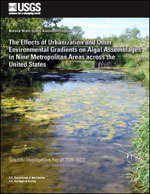The U.S. Geological Survey conducted studies from 2000 to 2004 to determine the effects of urbanization on stream ecosystems in nine major metropolitan study areas across the United States. Biological, chemical, and physical components of streams were assessed at 28 to 30 sites in each study area. Benthic algae were sampled to compare the degree to which algal assemblages correlated to urbanization, as characterized by an urban intensity index (UII), relative to other environmental gradients that function at either the watershed or reach scales. Ordination site scores were derived from principal components analyses of the environmental data to define environmental gradients at two spatial scales: (1) watershed-scale gradients that summarized (a) landscape modifications and (b) socioeconomic factors, and (2) reach-scale gradients that characterized (a) physical habitat and (b) water chemistry. Algal response was initially quantified by site scores derived from nonmetric multi-dimensional scaling ordinations of the algal assemblage data. The site scores were then correlated with a set of algal metrics of structure and function to help select specific indicators that would best represent changes in the algal assemblages and would infer ecological condition. The selected metrics were correlated to the UII and other environmental gradients. The results indicated that diatom-taxa in the assemblages were distinctly different across the nine study areas, likely due to physiographic differences across the country, but nevertheless, some algal metrics were applicable to all areas. Overall, the study results indicated that although the UII represented various landscape changes associated with urbanization across the country, the algal response was more strongly related to more specific factors generally associated with water quality measured within the stream reach.


